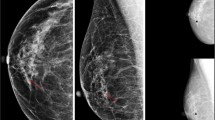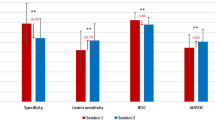Abstract
Background
During locally organized quality assurance evaluation sessions for screening radiologists, we noticed that individual screening radiologists did miss tumours which in our opinion could be detected at a distance.
Aim
To determine whether tumours missed by individual screening radiologists can be detected at a distance.
Methods
Twenty-eight screening mammograms of 28 females (mean age 63 years, range 49–73) with a pathologically proven malignant tumour missed by individual screening radiologists were mixed with 56 normal screening mammograms of 56 females (mean age 63 years, range 53–74). This test set was independently assessed by a senior screening radiologist and by a radiology resident without prior training in screening mammography at 1.5 m distance from the screen display. Readers were unaware of the prevalence of pathologically proven malignant tumours in the test set. Primary outcome was whether the reader would recall the woman.
Results
The senior screening radiologist recalled 28 of 28 women with a pathologically proven malignant tumour (sensitivity of 100%) and 16 of 56 women without pathology (specificity of 71%). The radiology resident recalled 25 of 28 women with a pathologically proven malignant tumour (sensitivity of 89%) and 10 of 56 women without pathology (specificity of 82%).
Conclusion
Some malignant tumours missed by an individual screening radiologist can be detected from 1.5 m distance. Therefore, we recommend that screening radiologists consciously take a distant view before closely evaluating the mammogram in detail.
Similar content being viewed by others
References
International Agency for Research on Cancer. World Health Organization. GLOBOCAN 2012. Available via http://globocan.iarc.fr/Pages/fact_sheets_population.aspx. Accessed 7 May 2016
Warner E (2011) Clinical practice. Breast-cancer screening. N Engl J Med 365:1025–1032
Fracheboud J, van Luijt PA, Sankatsing VD et al (2014) National evaluation of breast cancer screening in the Netherlands. 1990–2011/2012 (XIII). Thirteenth evaluation report. National Evaluation Team for Breast cancer screening (NETB), Rotterdam
Boyer B, Hauret L, Bellaiche R, Gräf C, Bourcier B, Fichet G (2004) Retrospectively detectable carcinomas: review of the literature. J Radiol 85:2071–2078
Saarenmaa I, Salminen T, Geiger U, Holli K, Isola J, Kärkkäinen A, Pakkanen J, Piironen A, Salo A, Hakama M (1999) The visibility of cancer on earlier mammograms in a population-based screening programme. Eur J Cancer 35:1118–1122
Timmers JM, van Doorne-Nagtegaal HJ, Zonderland HM et al (2012) The breast imaging reporting and data system (BI-RADS) in the Dutch breast cancer screening programme: its role as an assessment and stratification tool. Eur Radiol 22:5
American College of Radiology (2013) American College of Radiology (ACR) Breast Imaging Reporting and Data System Atlas (BI-RADS), 5th edn. Reston (Va)
Landis JR, Koch GG (1977) The measurement of observer agreement for categorical data. Biometrics 33:159–174
Nodine CF, Kundel HL (1987) Using eye movements to study visual search and to improve tumor detection. Radiographics 7:1241–1250
Daly CA, Apthorp L, Field S (1998) Second round cancers: how many were visible on the first round of the UK National Breast Screening Programme, three years earlier? Clin Radiol 53:25–28
Goergen SK, Evans J, Cohen GP, MacMillan JH (1997) Characteristics of breast carcinomas missed by screening radiologists. Radiology 204:131–135
Haygood TM, Wang J, Atkinson EN, Lane D, Stephens TW, Patel P, Whitman GJ (2009) Timed efficiency of interpretation of digital and film-screen screening mammograms. AJR Am J Roentgenol 192:216–220
Timmers JM, Verbeek AL, Pijnappel RM, Broeders MJ, den Heeten GJ (2014) Experiences with a self-test for Dutch breast screening radiologists: lessons learnt. Eur Radiol 24:294–304
Schell MJ, Yankaskas BC, Ballard-Barbash R, Qaqish BF, Barlow WE, Rosenberg RD, Smith-Bindman R (2007) Evidence-based target recall rates for screening mammography. Radiology 243:681–689
Pow RE, Mello-Thoms C, Brennan P (2016) Evaluation of the effect of double reporting on test accuracy in screening and diagnostic imaging studies: a review of the evidence. J Med Imaging Radiat Oncol 60(3):306–314
Acknowledgements
The authors thank M.S.O. van Wissen, MD for reading the test set during her residency in radiology.
Author information
Authors and Affiliations
Corresponding author
Ethics declarations
Conflict of interest
Authors declare that they have no conflict of interest.
Ethical approval
All procedures performed in studies involving human participants were in accordance with the ethical standards of the institutional and/or national research committee and with the 1964 Helsinki Declaration and its later amendments or comparable ethical standards.
Informed consent
In accordance with the national Data Protection Act, women were informed at screening that their data could be used anonymously for scientific research. Women can opt out, if they do not agree. The test set only consisted of screening mammograms of women who agreed to opt in.
Rights and permissions
About this article
Cite this article
Schreutelkamp, I.L., Kwee, R.M., Veekmans, P. et al. Breast cancers missed by screening radiologists can be detected by reading mammograms at a distance. Ir J Med Sci 188, 289–293 (2019). https://doi.org/10.1007/s11845-018-1828-8
Received:
Accepted:
Published:
Issue Date:
DOI: https://doi.org/10.1007/s11845-018-1828-8




